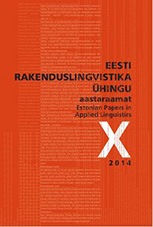Adjektiivide polüseemia korpuses ja sõnaraamatus
ADJECTIVAL POLYSEMY IN CORPORA AND DICTIONARIES
Author(s): Maria TuulikSubject(s): Language and Literature Studies
Published by: Eesti Rakenduslingvistika Ühing (ERÜ)
Keywords: semantics; lexicology; lexicography; word formation; semantic types; Estonian
Summary/Abstract: The article describes and analyzes the 100 most frequent Estonian adjectives with regard to both polysemy and morphological structure. Also examined is the polysemy index, i.e. the average number of meanings per word, for root adjectives, derivatives, compound words and participles. The most polysemous of these are root adjectives, with a polysemy index of 5. The polysemy index of derivatives is roughly half that, 2.6. Among the 100 most frequent adjectives, the least polysemous are compound words (polysemy index 1.3). The second half of the article discusses the application of semantic types, both as a theoretical aid in the analysis of polysemous words and as a practical tool in the coding of semantic information in dictionaries. Based on the primary meanings of the 100 most frequent adjectives as given in the single-volume explanatory dictionary of Estonian, 15 semantic types are proposed in order to describe Estonian (polysemous) adjectives. The next planned step, made possible by the existence of the semantic types, is to introduce the patterns of systematic adjectival polysemy in Estonian. The aim of this would be to study Estonian adjectival polysemy and establish a theoretical framework on the basis of which the presentation of adjectival polysemy in dictionaries could be harmonized.
Journal: Eesti Rakenduslingvistika Ühingu aastaraamat
- Issue Year: 2014
- Issue No: 10
- Page Range: 307-317
- Page Count: 11
- Language: Estonian

